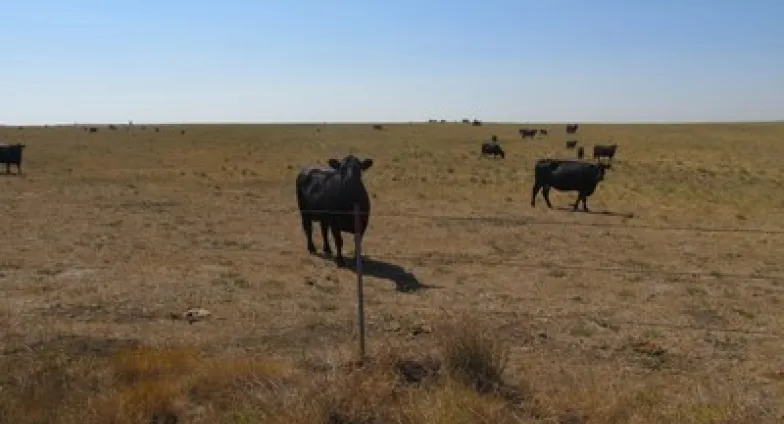Integrating Field Crops and Coproducts into Beef Cow Diets May Help Producers in Drought
As drought conditions develop and persist in parts of North Dakota, beef cow producers are looking for feeding options for their herds.
North Dakota State University Carrington Research Extension Center research into the feeding potential of many different alternative feeds, drylot management and early weaning can be helpful information for feeding and managing a cow herd during drought.
According to Vern Anderson, NDSU Carrington REC animal scientist emeritus, North Dakota has a wide variety of abundant feed resources for beef cows and potentially for increasing backgrounding and finishing calves. NDSU research results have shown that cows can be fed a wide variety of feeds that, if properly balanced for a cow’s genetic potential, will support satisfactory reproductive performance, good cow condition and healthy calves.
"More responsibility falls on the manager to formulate diets to match respective gestation or lactation needs when cows are pen-fed versus allowing cows to graze," Anderson says.
Some of the feeds used successfully in balancing diets for lactating cows included small-grain straws (wheat, oats, barley) and several oilseed meals (canola, sunflower, linseed), screenings of all kinds (wheat, sunflower, pea, flax, barley), coproduct feeds (soy hulls, barley malt pellets, wheat midds, oat hulls, potato processing waste, distillers grains, corn gluten feed or beet pulp).
Conventional grains, such as corn, peas and barley, may be priced out of the market based on their nutritional value. Anderson says coproduct feeds may be preferred to grains because they contain more protein and fiber and the starch from grains will reduce forage digestibility to some degree. For optimum forage digestion, Anderson suggests limiting grain to 4 pounds per day. Each producer’s situation is different, so local adaptation and feed cost assessment is critical.
"It may be more economical to ‘limit feed’ cows by providing them a restricted amount of a nutrient-dense feed, such as barley malt or soy hulls,” Anderson says. “Cows will do fine on limited amounts of grain or coproduct feeds provided each cow gets its share. Forage is certainly the mainstay, but cows can get along on less than a full stomach if the nutrients are there, but it takes a better fence.”
There are some concerns of vitamin and mineral nutrition with the extensive use of coproducts. Anderson recommends a vitamin A supplement that easily and inexpensively can be injected or added as a dry supplement to the feed. Extra calcium also may be needed to balance higher phosphorus levels, so a micro-mineral supplement is recommended. Palatability issues are not common, but can be avoided by mixing questionable feeds with other ingredients.
"Although the research in integrating crops and cows was not conducted as a drought strategy, our experience with drylot cows provides good basic information on how cattle producers can manage cows and early wean calves," Anderson says.
He reminds producers that cow health and condition should be evaluated continually and beef cattle specialists and consultants should be contacted if producers have questions on feeds or strategies for feeding.
